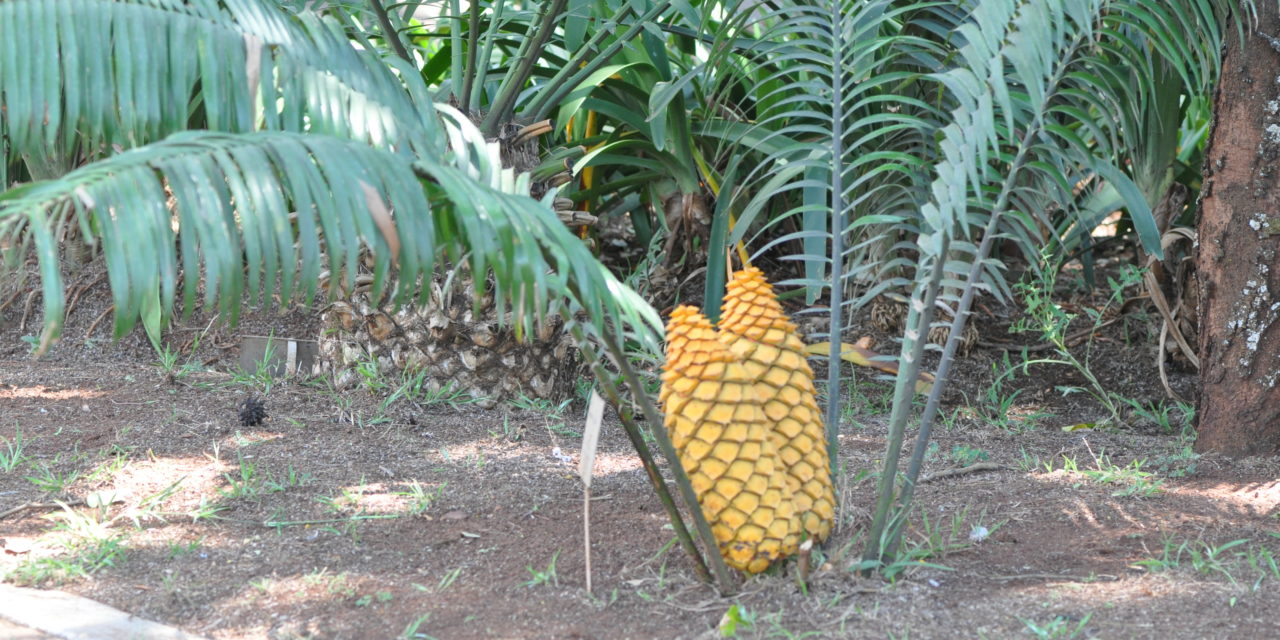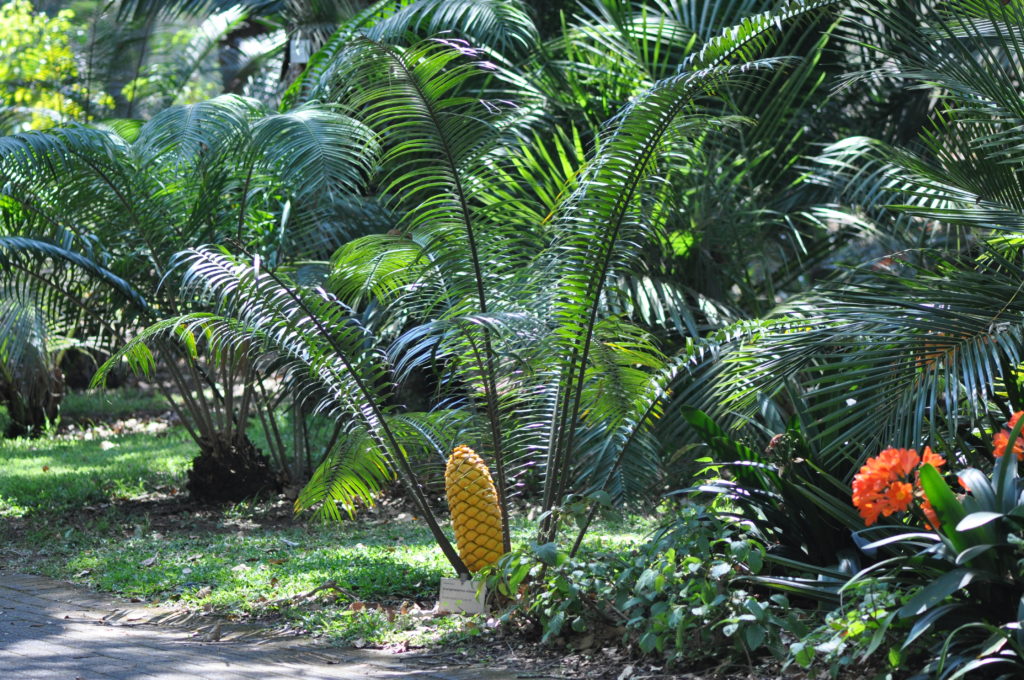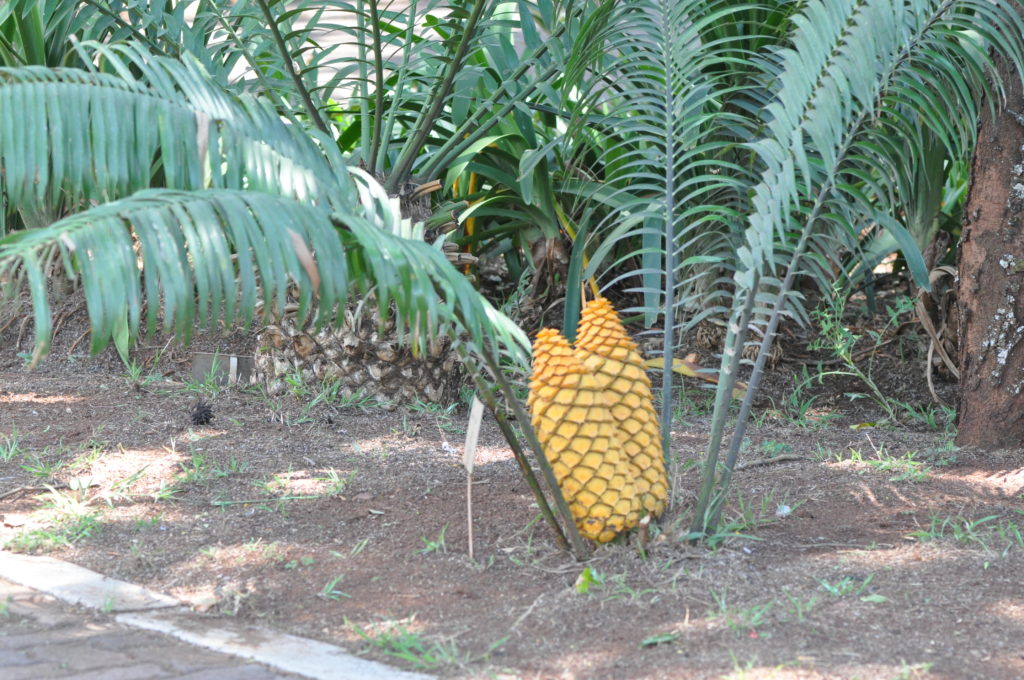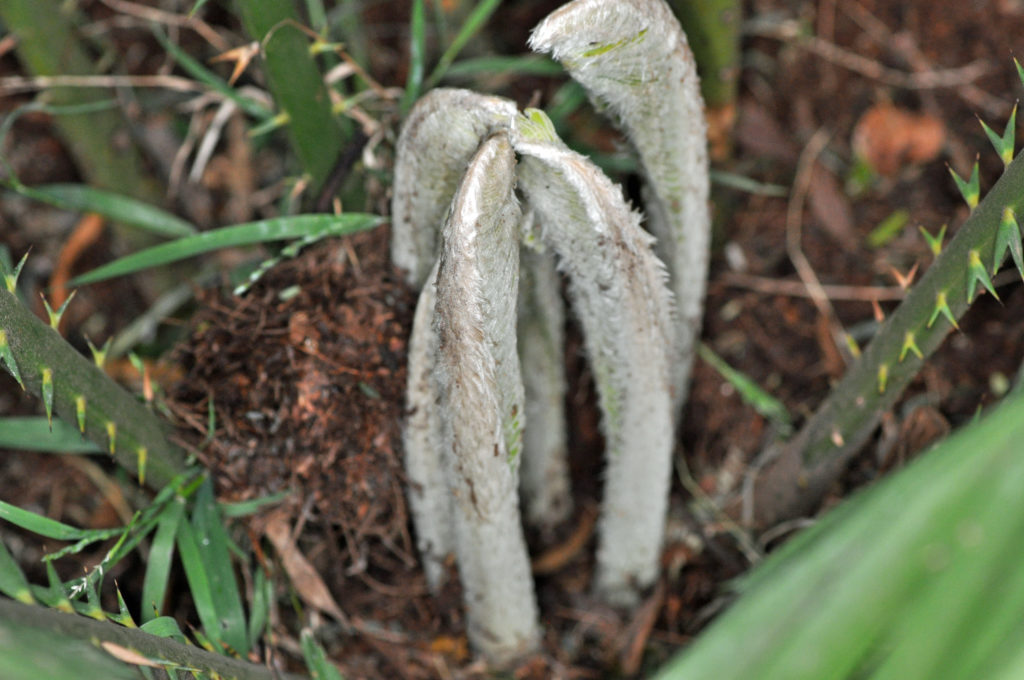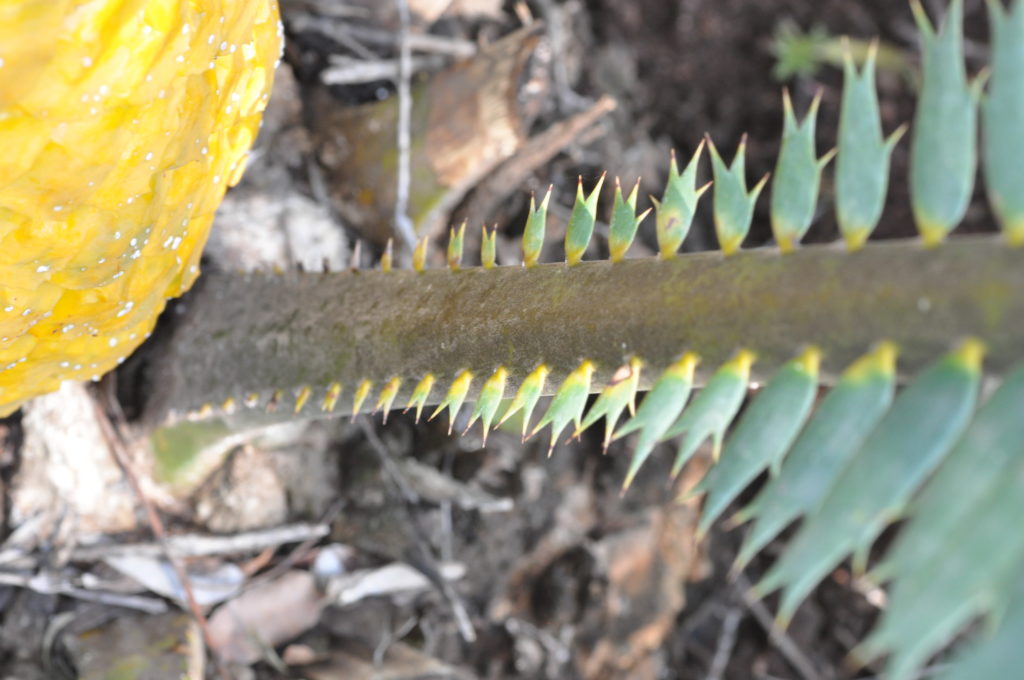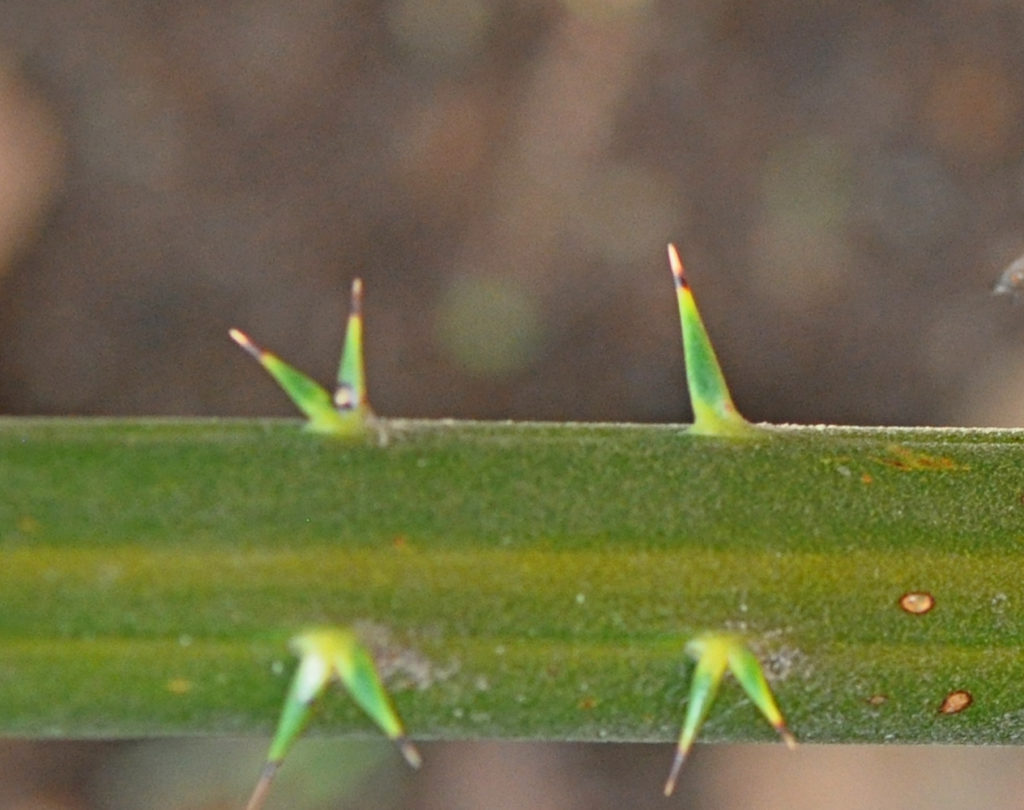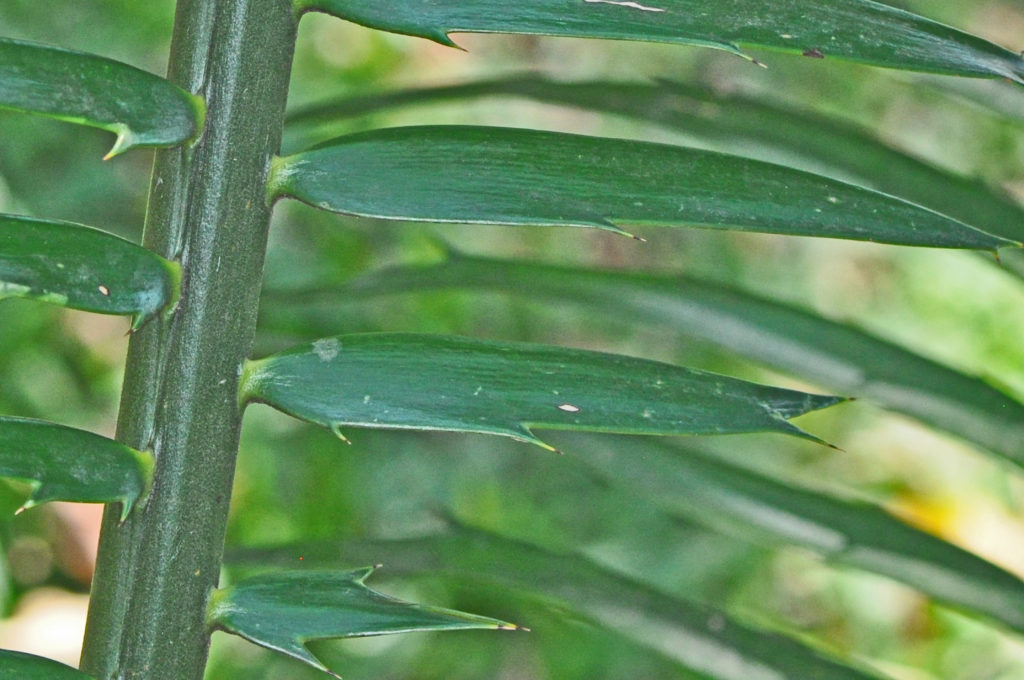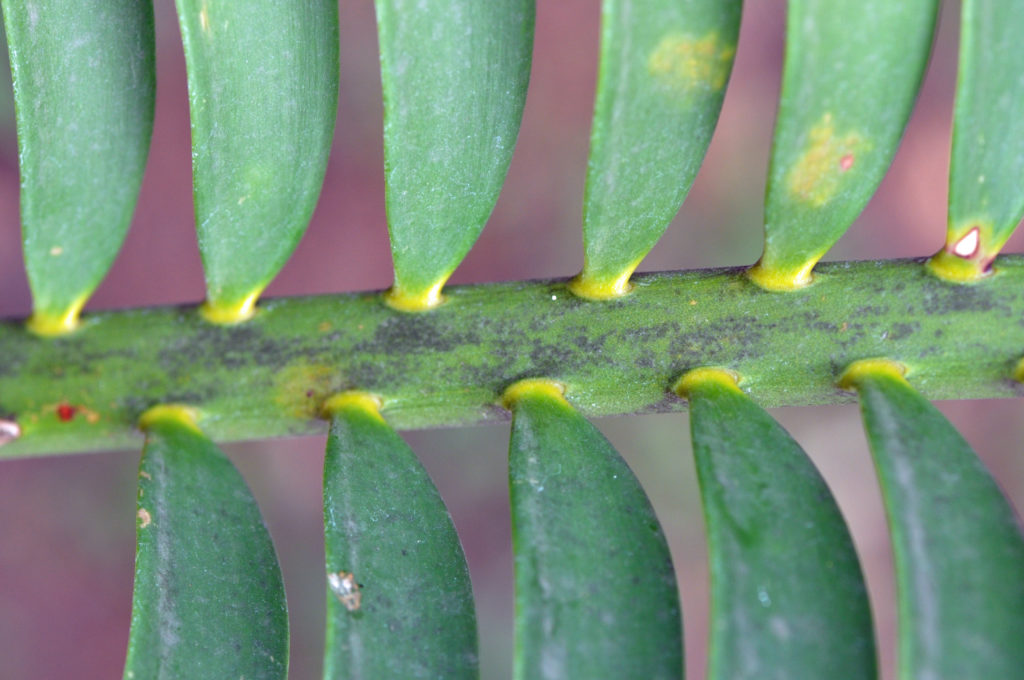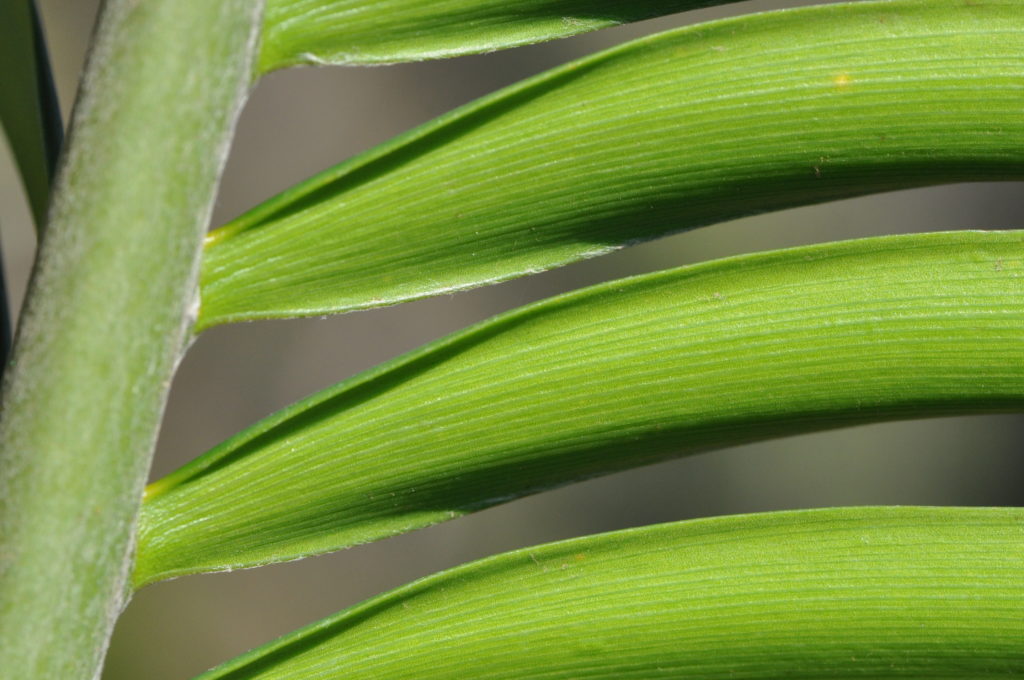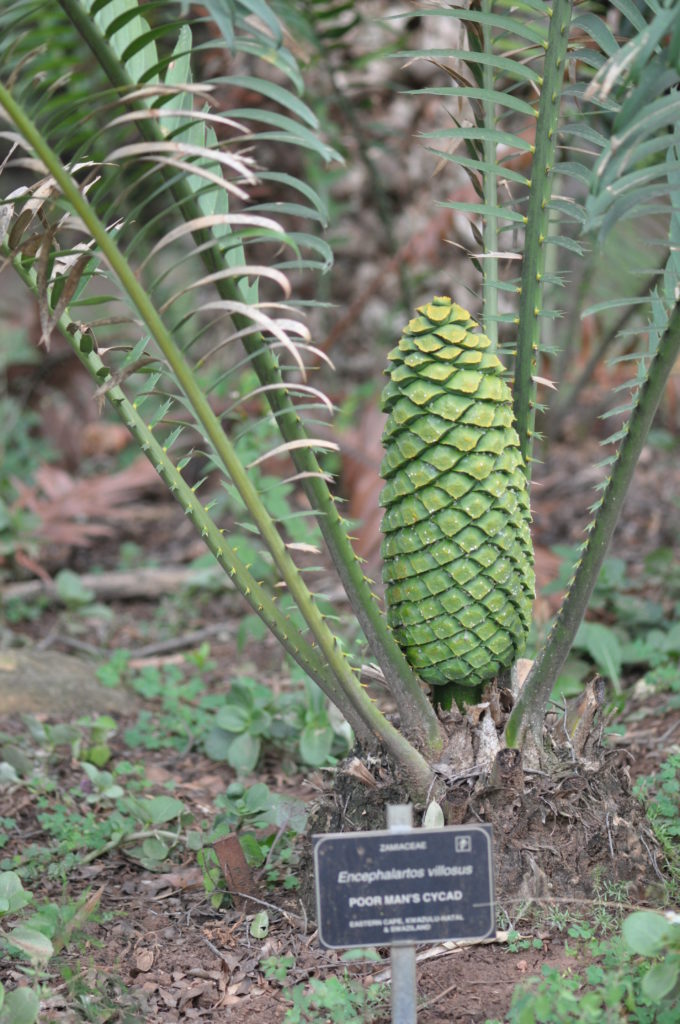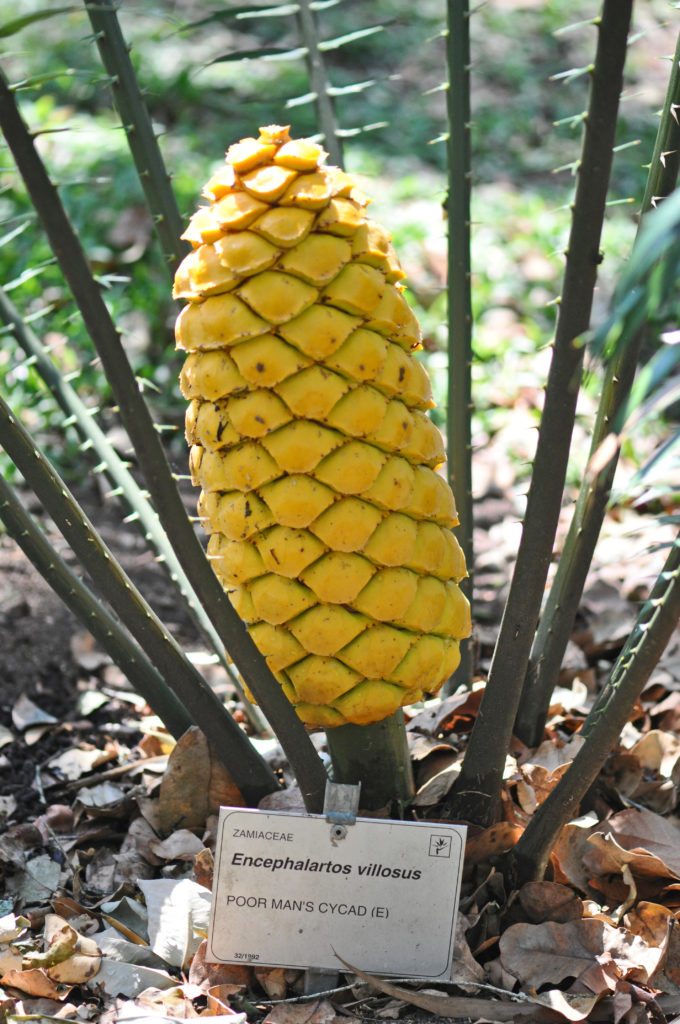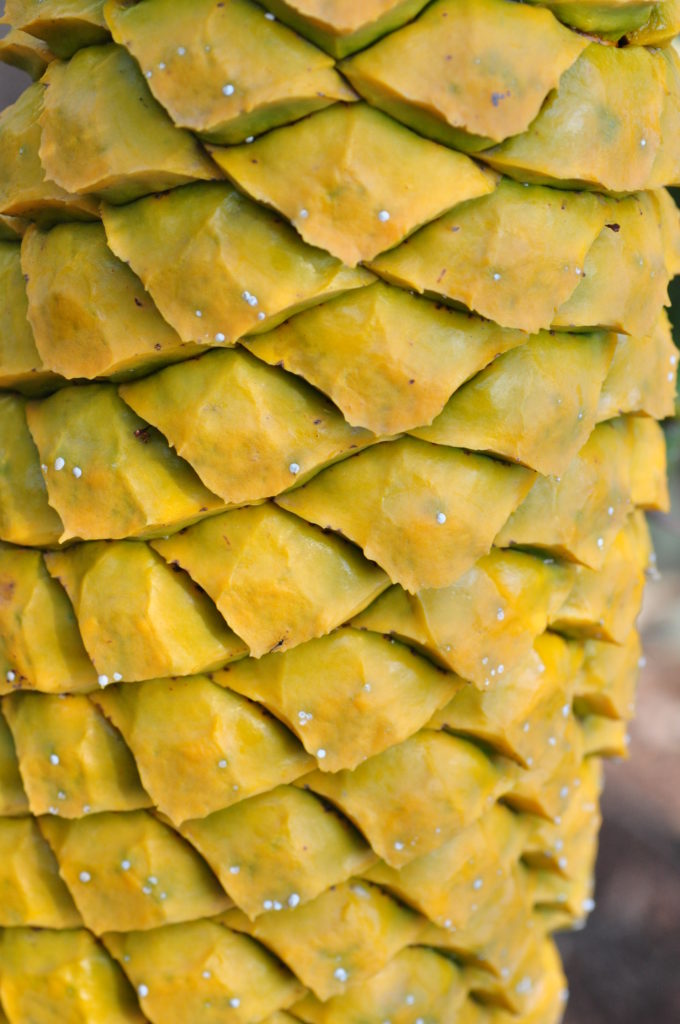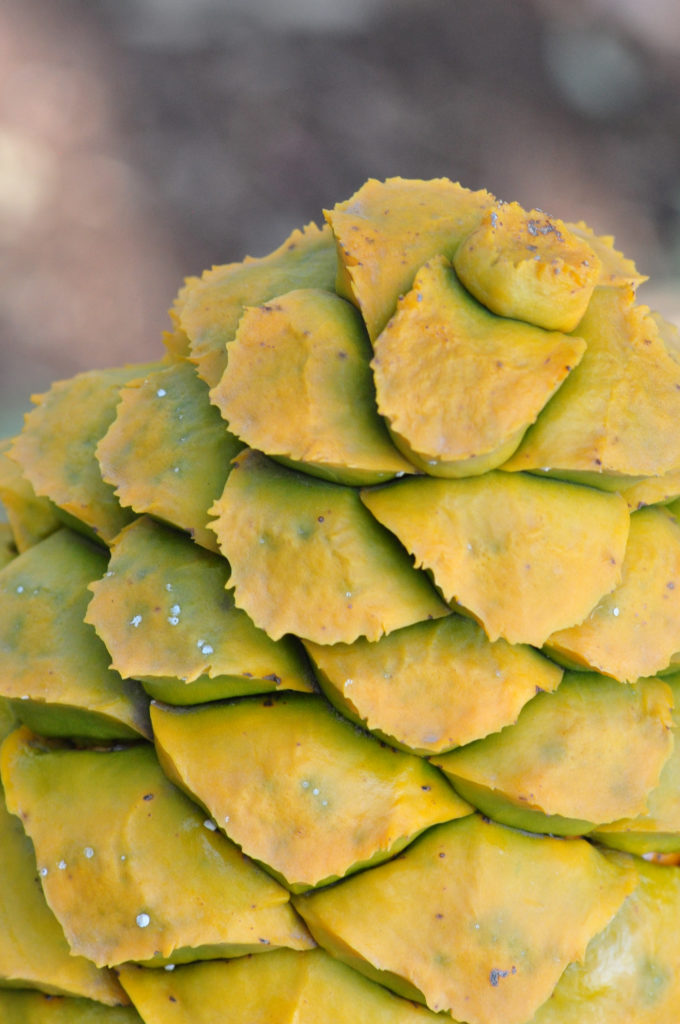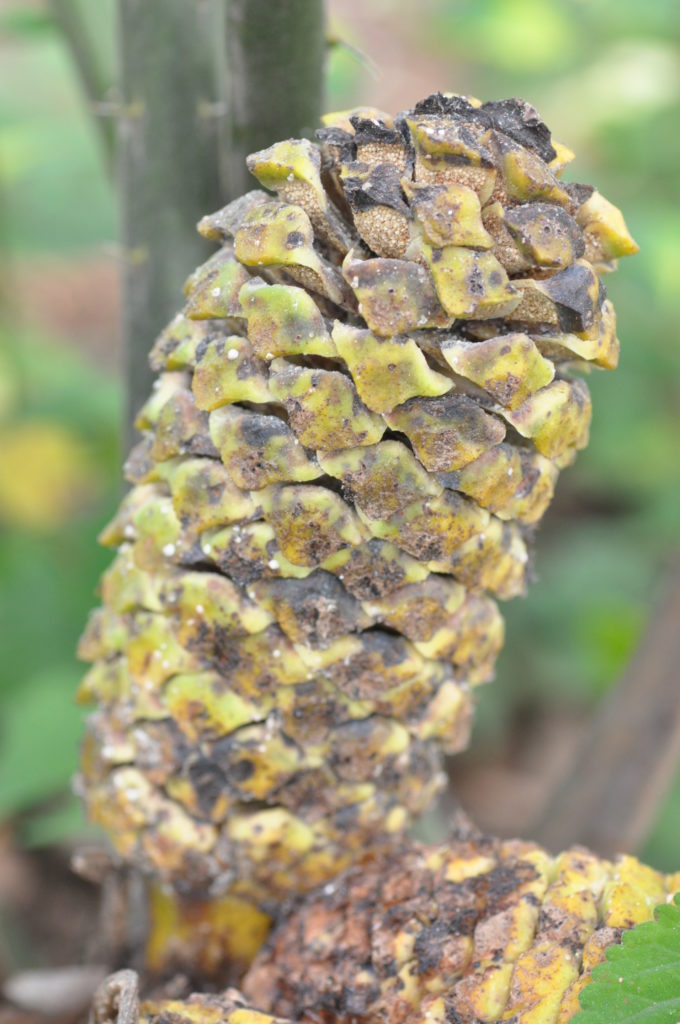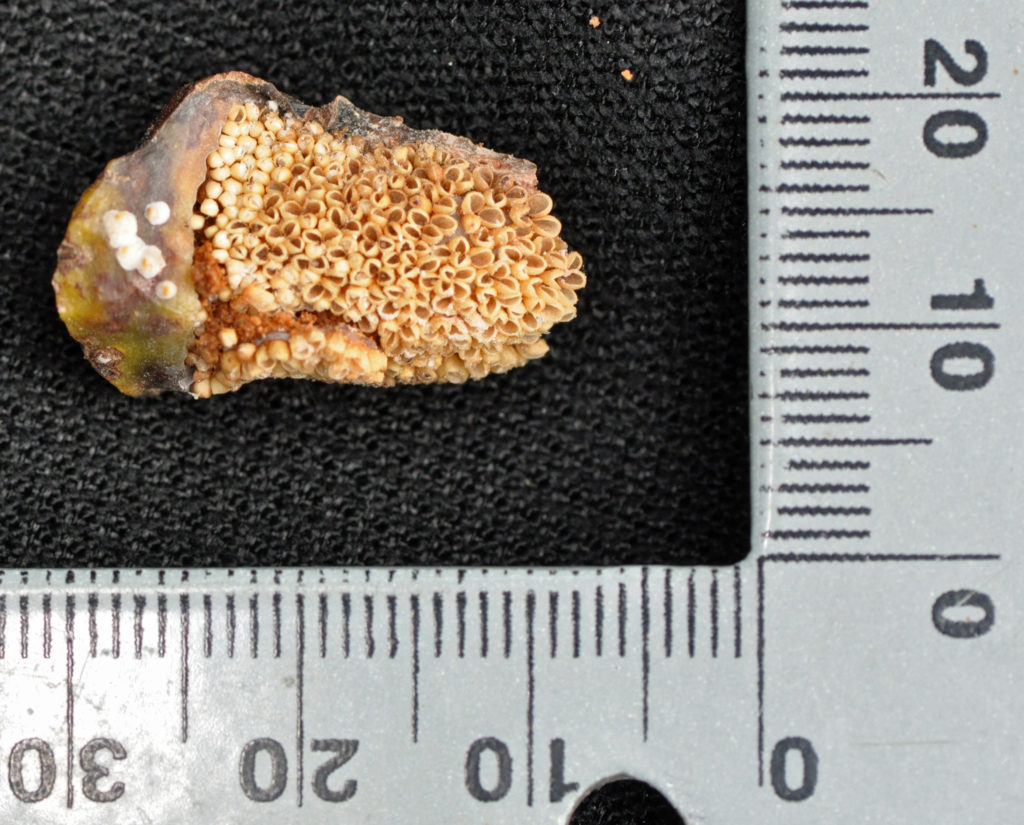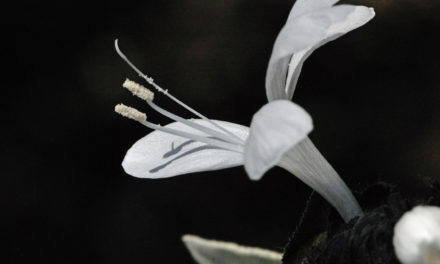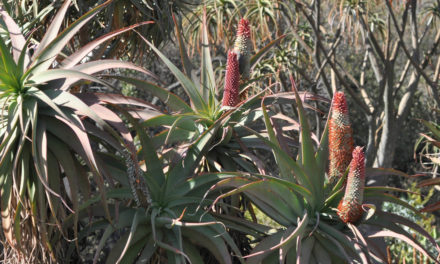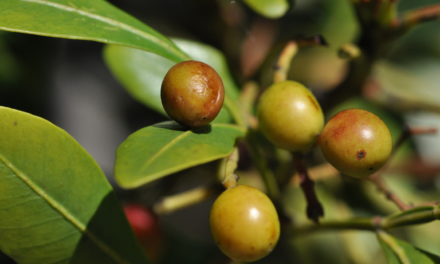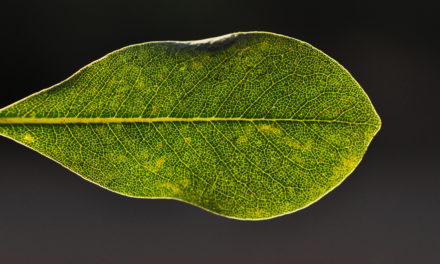General Info – summary
This southern African endemic is an attractive fast growing, dioecious Plant – up to 20cm high with a mainly subterranean stem. The crown of pinnately compound Leaves may reach 6m wide. Leaflets size decreases down the leaf becoming spiny. The up to 5 Male Cones have motile sperm. Pollinators are beetles. Yellow Female Cones reach up to 50 x 15cm. Red, poisonous, naked Seeds are up to 2 x 2cm.
Description
Encephalartos villosus
Previous Name: Encephalartos striatus.
SA Tree No. n/a.
Common names: (Afr) Stamlose Broodboom. (Eng) Ground Cycad, Poor Man’s Cycad. (isiXhosa) Umgusa, Umphanga. (isiZulu) Isidwaba-somkhovu, Isigqikisomkhovu, Isikomakhoma Sehlati.
Family: Zamiaceae. This family is part of the major group: Gymnosperms. Zamiaceae are usually cone-bearing plants producing naked seeds and include Ginkgo (in China), Cycads, Conifers (e.g., pine trees) and Gnetophytes: e.g., the unique Welwitschia mirabilis (tweeblaarkanniedood) are not wind pollinated and found in the deserts of western Namibia and southern Angola. Members of the gymnosperm family Zamiaceae have no flowers or fruit and the seeds are often contained in Cones. This family has 8 genera, including the Genus Encephalartos, which contains all species of cycads.
Name derivation: Encephalartos – within-head-bread: referring to the starchy bread that can be made from the pith of the inner trunk. villosus – softly hairy: referring to the crown of young leaves (photo 615 under Leaves). All cycads fall into the genus Encephalartos, which includes some of the most primitive living Gymnosperms. The gymnosperm family Zamiaceae has 9 genera including Encephalartos (cycads). The African plants in the genus Encephalartos include about 66 species with about 35 species in southern Africa.
Conservation: National Status: L C. (Least Concern). 2009 (J.S. Donaldson). This common plant is widespread but decreasing in some areas.
Tree
Species of Encephalartos (Cycads) are only superficially palm or fern like and are usually unbranched. The cycad tap Root is usually soon replaced by lateral roots, which become woody.
In Encephalartos villosus the Trunk is mainly subterranean (below ground), although it is often slightly exposed. This plant is considered to be a dwarf cycad. The maximum height of the trunk above ground is 40cm and the diameter is up to 25cm. The inner Crown is woolly, and the plant has a leaf spread of up to 6m. This relatively fast-growing plant may occasionally have suckers and the plant may appear to be multi-stemmed.
- 738. 2019/09/16. Lowveld NBG. Photo: David Becking.
- 562. 2014/10/30 Pretoria NBG. Photo: David Becking.
Leaves
Cycads are unique gymnosperms with Leaves that are pinnately compound (leaflets arranged along either side of the leaf rachis, the central stalk, like a feather). Only Leaf Scars eventually remain on the trunk once the leaves (including the delayed falling of the petiole) fall. Unlike other members of the family Zamiaceae, the cycads have leaflets that lack a central Midrib (vein). The hard leaflets do not bend easily, and the leaf veins are parallel. Stomata (structure utilising 2 guard cells that, unlike lenticels, can control gaseous exchange) are present on the leaves.
This cycad has leaves that may reach 3m long. Young leaves have white hairs (photo 615) which are lost in the mature arching leaves. The mature Leaflets (a leaf-like part of a compound leaf; secondary leaf) are glossy, dark green above (photo 635). The lower surface is a lighter green and here the parallel venation is clearly visible (photo 1218). Leaflets do not overlap (photo 635). Their shape is variable and may be sickle-shaped. The median leaflets are the largest and up to 25 x 2cm. Leaflets become smaller towards the leaf base and are eventually spine-like (photo 724 & 739). Prickles may occur on both leaflet Margins (photo 740).
- 615. 2017/01/31. Pretoria NBG. Photo: David Becking.
- 724. 2016/08/30. Walter Sisulu NBG. Photo: David Becking.
- 739. 2014/09/16. Lowveld NBG. Photo: David Becking.
- 740. 2014/09/16. Lowveld NBG. Photo: David Becking.
- 635. 2016/04/05. Walter Sisulu NBG. Photo: David Becking.
- 1218. 2015/08/18. Walter Sisulu NBG. Photo: David Becking.
Cones
Gymnosperms have unenclosed or naked seeds. They have no flowers or fruit, and the seeds are often contained in cones. In the Angiosperms (flowering plants), the seeds are enclosed in an ovary. In the Gymnosperms, there are 2 modes of fertilization. In all the Cycads (including Encephalartos) and the single extant (not extinct) species of Ginkgo biloba, the male cones produce motile sperms, which do not move along a pollen tube. The remaining members of the Gymnosperms all have non-motile sperm with no flagella and are moved along through a Pollen tube to the egg. Cycads are Dioecious (having male and female cones on separate plants). Most gymnosperms develop Cones during their reproductive phase. These cones develop in the centre of the leaf whorls. At maturity, cycad Seeds are released when the Female cones disintegrate.
In Encephalartos villosus up to 5 light yellow or greenish Male Cones are formed. They open and become darker when mature (photo 638). Each male cone is up to 15cm long. There are up to 4 Female Cones, which are each perched on a stout stalk (photo 737). They are initially green (photo 634) and become yellow at maturity. Each female cone is up to 50cm x 15cm and produces naked ovules (not enclosed in an ovary). The tree is insect pollinated and Beetles (Order Coleoptera: with front wings modified into wing cases), have been identified as the most common pollinators of cycads. Seeds are about 2 x 2cm, deep red and enclosed in a fleshy layer. Birds collect and consume only the fleshy outer covering, leaving the seeds behind – thus aiding in dispersal.
- 634. 2016/04/05. Walter Sisulu NBG. Photo: David Becking.
- 737. 2014/09/16. Lowveld NBG Photo: David Becking.
- 719. 2016/08/30. Walter Sisulu NBG. Photo: David Becking.
- 720. 2016/08/30. Walter Sisulu NBG. Photo: David Becking.
- 638. 2016/04/05. Walter Sisulu NBG. Photo: David Becking. Mature Male Cone.
- 639. 2016/04/05. Walter Sisulu NBG. Photo: David Becking.
Distribution & Ecology
Cycads have Coralloid Roots that contain symbiotic cyanobacteria (blue-green algae) that fix atmospheric nitrogen. Through a process of complex biological pathways, the cyanobacteria convert atmospheric molecular nitrogen into compounds such as ammonia, and amino acids needed by the cycads.
Encephalartos villosus is the most widespread, frost resistant cycad, and is a southern Africa Endemic (restricted to a particular geographic location). In Southern Africa it occurs along the eastern coastal belts, from East London up the Eastern woodland, including Lebombo Mountains through KwaZulu-Natal and Eswatini (Swaziland). Examples can be seen in the Krantzkloof reserve between Pinetown and Hillcrest and the Botanical Gardens in Durban, Lowveld, Pretoria and Walter Sisulu. Plants are usually located in low frost, dry ravine forests with a summer rainfall range of 850 – 1 300mm. Birds – including the purple crested Turacos (louries) and trumpeter hornbills, aid seed dispersal.
Ethnobotany
This Cycad grows relatively quickly (5 years to look good) and should be planted in light shade. Hybrid species occur. For viable seed development, both male and female plants need to be relatively close to each other. All seeds produce carcinogenic and neurotoxic glycosides (cycasins). These are poisonous to mammals – including man. Always wear gloves when handling seeds.
References
Boon, R. 2010. Pooley’s Trees of eastern South Africa. Flora and Fauna Publications Trust, Durban.
Donaldson, J.S. 2009. Encephalartos villosus Lem. National Assessment: Red List of South African Plants version 2020.1. Accessed on 2023/04/28.
http://www.plantzafrica.com/plantefg/voteplant.php
https://en.wikipedia.org/wiki/Encephalartos_villosus
http://www.cycadpalm.com/seed-grown-encephalartos.html
http://cycadsociety.org/?page_id=1836
http://pza.sanbi.org/encephalartos-villosus
http://plantnet.rbgsyd.nsw.gov.au/cgi-bin/cycadpg?taxname=Encephalartos+villosus
http://biodiversityadvisor.sanbi.org/wp-content/uploads/sanbi-identify-it/plants/encephalartos.htm
http://www.theplantlist.org/browse/G/Zamiaceae/
https://www.diffen.com/difference/Angiosperms_vs_Gymnosperms
https://en.wikipedia.org/wiki/Belidae

